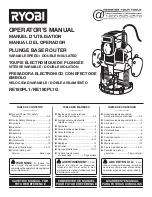
Allied Telesis
www.alliedtelesis.com
AT-9424T
| 24 Port 10/100/1000T Managed Layer 3 Switch
Hardware Specifications
Physical Characteristics
Dimensions (H x W x D)
4.4cm x 43.8cm x 30.48cm
(1.75in x 17.3in x 12in)
Weight
4.21kg
(9.35lbs.)
System Capacity
200MHz PowerPC CPU
4096 VLANs
16000 MAC addresses
8 Megabytes file system
Performance
Wirespeed switching on all Ethernet ports
14,880pps for 10Mbps Ethernet
148,800pps for 100Mbps Ethernet
1,488,000pps for 1000Mbps Ethernet
Ethernet throughput
71.424Mpps
Switch fabric
96Gbps
Power Characteristics
Voltage:
100-240V AC
Current:
4.0/2.0A
Frequency:
50-60Hz
Max power consumption:
54 Watts
Environmental Specifications
Operating temperature:
0ºC to 40ºC
(32ºF to 104ºF)
Storage temperature:
-25ºC to 70ºC
(-13ºF to 158ºF)
Operating humidity:
5% to 90% non-condensing
Storage humidity:
5% to 90% non-condensing
Max operating altitude:
3,048m (10,000 ft)
Recommended ventilation on all sides: 10cm (4.0 in.)
MTBF
250,000 hrs.
Electrical/Mechanical Approvals
Safety UL 60950-1, CSA C22.2 No. 60950-1-03,
EN60950-1, EN60825-2 (TUV)
EMI FCC Part 15 Class A, EN55022 Class A, EN55024
Immunity, VCCI Class A, C-TICK, EN61000-3-2,
EN61000-3-3, AS/NZS 3548 (Australia/New Zealand)
Immunity EN55024
Country of Origin
Singapore / China
Software Specifications
Layer 3 Support
RIPv1
RIPv2
ECMP
Static IPv4 Routing (128 routes)
Interface Standards
IEEE 802.3
10T
IEEE 802.3u
100TX and 100FX
IEEE 802.3z
1000SX
IEEE 802.3ab
1000T
General Standards
IEEE 802.1d
Bridging
IEEE 802.3ac
VLAN tag frame extension
IEEE 802.3x
BackPressure/ flow control
Redundancy
Static and dynamic port trunking (with six trunk
groups and up to 8 ports per trunk)
IEEE 802.3ad
LACP link aggregation
IEEE 802.1D
Spanning-Tree Protocol
IEEE 802.1w
Rapid Spanning-Tree
IEEE 802.1s
Multiple Spanning-Tree
Router Redundancy Protocol (RRP) snooping
Dual software images, dual configuration files
Traffic Management Quality
of Services (QoS)
Layer 2, 3 and 4 criteria
Flow groups, traffic classes and policies
DSCP replacement
IEEE 802.1Q priority replacement
Type of Service replacement
Type of Service to IEEE 802.1Q priority replacement
IEEE 802.1q Priority to Type of Service replacement
Maximum bandwidth control
Burst size control
Ingress rate limiting
Head of line blocking prevention
Support for ingress and egress ports
Eight egress queues per port
IEEE 802.1p Class of Service with Strict and Weighted
Round Robin Scheduling
Multicast
RFC 1112
IGMP snooping (v1)
RFC 2236
IGMP snooping (v2)
RFC 3376
IGMP snooping (v3)
RFC 2710
Multicast Listener Discovery
(MLD) snooping (v1)
RFC 3810
Multicast Listener Discovery
(MLD) snooping (v2)
Management and Monitoring
RFC 1157
SNMPv1
RFC 1901
SNMPv2
RFC 3411
SNMPv3
RFC 1213
MIB-II
RFC 1215
TRAP MIB
RFC 1493
Bridge MIB
RFC 2863
Interfaces group MIB
RFC 1643
Ethernet-like MIB
RFC 1757
RMON 4 groups: Stats,
History, Alarms and Events
RFC 2674
IEEE 802.1Q MIB
RFC 1866
HTML
RFC 2068
HTTP
RFC 2616
HTTPS
RFC 854
Telnet server
RFC 1350
TFTP client
Allied Telesis Private MIB
IP address allocation:
RFC 951 / RFC1542
BOOTP client
RFC 2131
DHCP client manual
RFC 2030
SNTP, Simple Network
Time Protocol
Syslog client
Two event logs:
4,000 event capacity in temporary memory
2,000 event capacity in permanent memory
Management Access Methods
Single IP address for management
Out of Band management (serial port)
In-band management (over the network) using Telnet,
Web browser or SNMP
Management Interfaces
Menus
Command line
Web browser
SNMP v1/ v2/ v3





















